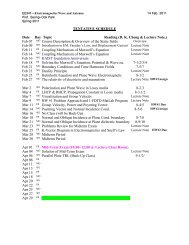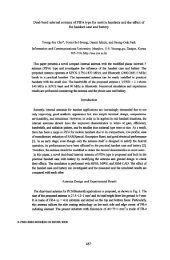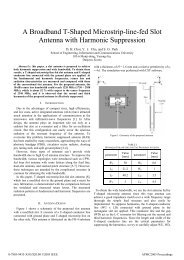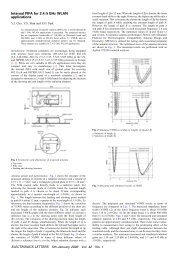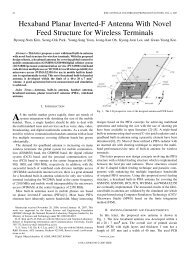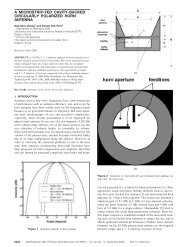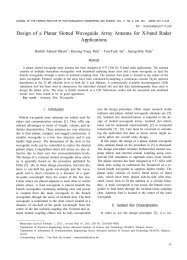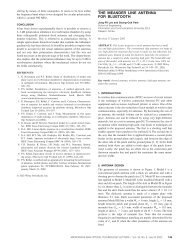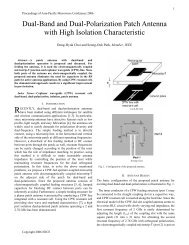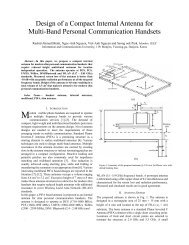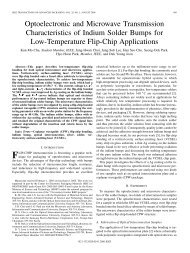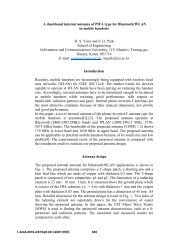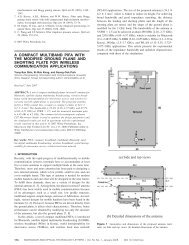ICE649 Microwave Engineering
ICE649 Microwave Engineering
ICE649 Microwave Engineering
Create successful ePaper yourself
Turn your PDF publications into a flip-book with our unique Google optimized e-Paper software.
<strong>ICE649</strong> — <strong>Microwave</strong> <strong>Engineering</strong> 4 Sept. 2002<br />
Lecture<br />
Autumn 2002<br />
<strong>ICE649</strong> <strong>Microwave</strong> <strong>Engineering</strong><br />
2003 Fall Semester<br />
Instructor: Seong-Ook Park, Ph. D. Tel: 866-6132, E-mail: sopark@mail.icu.ac.kr<br />
Class Hours: Thu 16:00~17:30 (4:00~5:30 pm)<br />
Thu 19:00~120:30 (7:00~8:30 pm)<br />
Prerequisites: ICE509 Electromagnetics<br />
Classroom: To be announced<br />
Office Hours: Room 23323, Wed: 11:00~12:00 am or by appointment<br />
Assistant: Dong-Hyack Choi<br />
Assistant’s Office Hours: 13:30 ~ 14:30 (Tue & Thu)<br />
Textbooks:<br />
1. Pozar, D., <strong>Microwave</strong> <strong>Engineering</strong>, 2nd Edition, John Wiley & Sons, 1998<br />
2. Lecture Note<br />
Reference : Additional recommended:<br />
1. Sigfrid Yngvesson; <strong>Microwave</strong> Semiconductor Devices<br />
2. Solid-State <strong>Microwave</strong> Power Oscillator Design, Eric Holzman, Artech House(1992)<br />
3. Vendelin, Pavio, Rohde, <strong>Microwave</strong> Circuit Design Using Linear and Nonlinear Techniques, J. Wiley<br />
& Sons, 1990<br />
4. Reinhold Ludwig, RF Circuit Design Theory and Applications, Prentice-Hall Inc. 2000<br />
Grading Policy: Midterm (30%), Final (40%), HW (15 %), Quiz ( %), Term Project (15 %),<br />
Course Objectives:<br />
The goal of this course is to introduce students to the concepts and principles of the advanced microwave<br />
engineering, including the use of computer aided design(CAD) methods. RF/microwave CAD is employed<br />
extensively in industry and a knowledge of the principles and methods used is important for anyone who may<br />
work in an RF/microwave related field. Theory and design of passive and active microwave components, and<br />
microwave circuits including: microstrip line, guided wave device, filter, amplifier, oscillators, and<br />
experimental characterization of above components using the network analyzer, spectrum analyzer, power and<br />
noise meters. In this course, the theoretical and practical concept of microwave engineering is useful<br />
applications to the analysis and design of microwave components, microwave circuits, and optics.<br />
The general flow of this class is Application --> System --> Component; individual components are analyzed by Fields --> Modes --><br />
Equivalent Network.<br />
Course Description:<br />
- Discusses the electrical property of material, and microwave application.<br />
- Analysis and design of planar transmission lines, matching circuits, passive and active microwave<br />
components, and microwave circuit, etc.<br />
Relationship to Other Courses and Prerequisite:<br />
The theoretical concepts of this course is useful to the understanding of microwave circuits and optics<br />
classes. And this class becomes directly useful in understanding the behavior of the field and we can<br />
make intelligent guesses as to how to improve the behavior of the RF/<strong>Microwave</strong> structures we are<br />
designing and analyzing. Prefer Prerequisite: ICE509 Electromagnetics, or equivalent knowledge, but not<br />
necessary requirement.<br />
Computer Usage:<br />
Computer aides design tools, such as ADS, are used to design, analyze and construct RF and <strong>Microwave</strong><br />
Circuits. Matlab
<strong>ICE649</strong> — <strong>Microwave</strong> <strong>Engineering</strong> 4 Sept. 2002<br />
Lecture<br />
Autumn 2002<br />
Course Schedule<br />
Fall 2003<br />
Week Topic Text Homework<br />
/Project<br />
1<br />
2<br />
3<br />
4<br />
5<br />
6<br />
7<br />
8<br />
9<br />
10<br />
11<br />
12<br />
13<br />
14<br />
Maxwell's equations review<br />
Transmission line, review of field and component relationship HW#1<br />
<strong>Microwave</strong> network analysis; S-parameter matrix,<br />
Signal flow graphs<br />
Measurement Techniques with Network Analyzer, Calibration HW#2<br />
De-embedding Technique<br />
E&M CAD, waveguides; TE, TM waves, modes, attenuation<br />
Passive RF Components and Equivalent Circuits<br />
<strong>Microwave</strong> resonators<br />
<strong>Microwave</strong> resonators<br />
Material measurement techniques<br />
Power dividers, hybrids & directional couplers<br />
Dividers & couplers (continued)<br />
De-embedding Technique with Package<br />
De-embedding Technique with Active Component<br />
Review<br />
Mid Exam.<br />
Filter (Floquet Mode Theorem & Periodic<br />
structure)<br />
Filter ( Photonic Band Gap, Rx/Tx Filter, Duplexer)<br />
Practical microwave component analysis<br />
Practical microwave system analysis<br />
Amplifiers<br />
<strong>Microwave</strong> CAD for amplifier design<br />
Oscillators<br />
<strong>Microwave</strong> CAD for oscillators<br />
Noise Figure and Measurement techniques<br />
Oscillator stability & noise (continued)<br />
HW#3<br />
HW#4<br />
HW#5<br />
HW#6<br />
HW#7<br />
Practical mw/mm <strong>Microwave</strong> System Project #1<br />
Practical mw/ mm <strong>Microwave</strong> System<br />
15 Review<br />
Final Exam.<br />
* Above schedule is subject to change.



